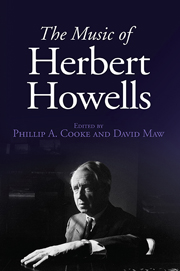Book contents
- Frontmatter
- Dedication
- Contents
- List of Illustrations
- List of Musical Examples
- List of Tables
- List of Contributors
- Foreword
- Acknowledgements
- Miscellaneous Frontmatter
- Introduction: Paradox of an Establishment Composer
- PART I Howells the Stylist
- PART II Howells the Vocal Composer
- 4 ‘Hidden Artifice’: Howells as Song-Writer
- 5 A ‘Wholly New Chapter’ in Service Music: Collegium regale and the Gloucester Service
- 6 Howells's Use of the Melisma: Word Setting in His Songs and Choral Music
- PART III Howells the Instrumental Composer
- PART IV Howells the Modern
- PART V Howells in Mourning
- Appendix: Catalogue of the Works of Herbert Howells
- Bibliography
- Index of Works
- General Index
4 - ‘Hidden Artifice’: Howells as Song-Writer
from PART II - Howells the Vocal Composer
Published online by Cambridge University Press: 05 December 2013
- Frontmatter
- Dedication
- Contents
- List of Illustrations
- List of Musical Examples
- List of Tables
- List of Contributors
- Foreword
- Acknowledgements
- Miscellaneous Frontmatter
- Introduction: Paradox of an Establishment Composer
- PART I Howells the Stylist
- PART II Howells the Vocal Composer
- 4 ‘Hidden Artifice’: Howells as Song-Writer
- 5 A ‘Wholly New Chapter’ in Service Music: Collegium regale and the Gloucester Service
- 6 Howells's Use of the Melisma: Word Setting in His Songs and Choral Music
- PART III Howells the Instrumental Composer
- PART IV Howells the Modern
- PART V Howells in Mourning
- Appendix: Catalogue of the Works of Herbert Howells
- Bibliography
- Index of Works
- General Index
Summary
Through the legacy of a song tradition kindled with such fertile imagination by his revered masters, Parry and Stanford, and the powerful ambience of a new, nationally conscious art, fired on the one hand by the co-option of Elizabethan and Jacobean verse and on the other by the prevalent contemporary aesthetic of both Housman and the emerging Georgian poets, it was perhaps inevitable for a neo-Elizabethan lyricist such as Herbert Howells, a lover of literature, prose and the spoken word, to turn the idiom of song into an expression of his own particular fastidious chemistry of melody and harmony. More to the point, however, the genre of solo song, as the ultimate miniature gestalt – a sum of more than the constituent parts of words, music, voice and accompaniment – was for Howells the opportunity to enshrine in music, on an intimate scale, those values of intricacy and involution. For him such values represented a deep artistic need for musical integrity on multiple architectonic levels, a mentality exemplified by the processual thinking of late-nineteenth-century German musical intellectualism and, above all, of Brahms. Such a mentality was of course especially prevalent in Brahms's instrumental essays, but it was also no less evident in his vocal works and especially in his many songs This predilection for Brahmsian artifice had, on the one hand, been instilled into Howells by Stanford (himself a supreme architect of songs), but the desire to express those most personal and private aspirations ultimately emanated from an atavistic emulation of the Tudor masters' artistic relationship between composer and his maker.
- Type
- Chapter
- Information
- The Music of Herbert Howells , pp. 62 - 85Publisher: Boydell & BrewerPrint publication year: 2013

